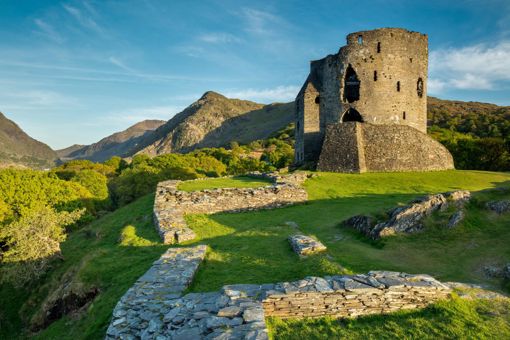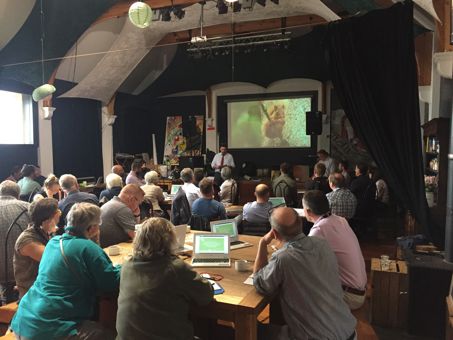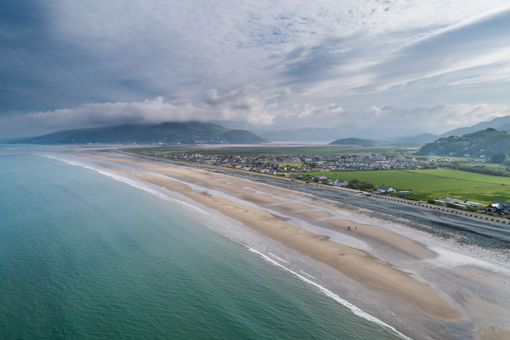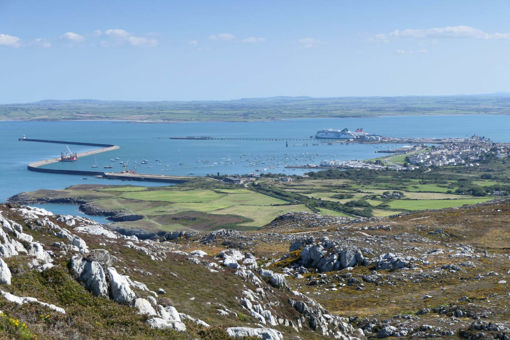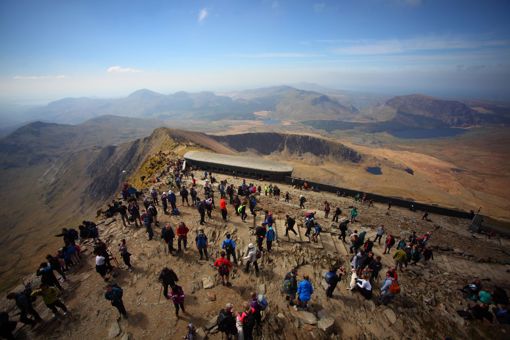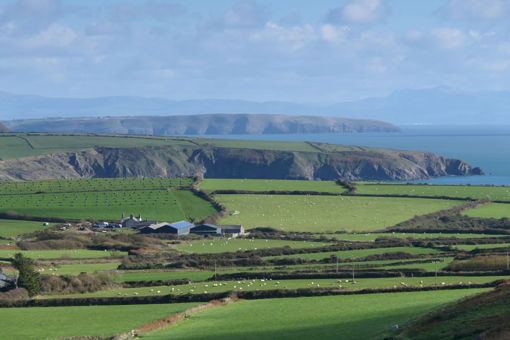Opportunities for a resilient ecosystem (working together to tackle the nature emergency)
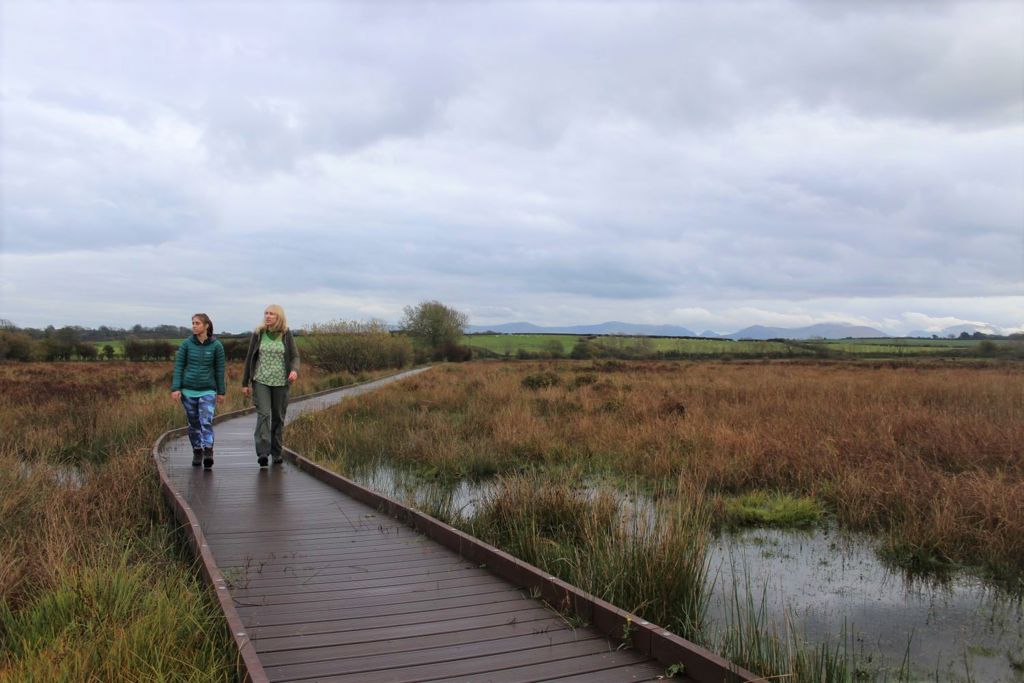
Opportunities for a resilient ecosystem
In this theme, Natural Resources Wales (NRW) wants to work with the people of Northwest Wales to improve the resilience of our fragile natural world and ecosystems. It’s clear there are any number of threats to the habitats, plants and animals across North West Wales. The global decline we’re seeing is being mirrored locally. We are currently experiencing a nature (biodiversity) emergency and it is essential we have resilient ecosystems to support species and habitats.
In Northwest Wales, we are developing our understanding of exactly what ecosystem resilience means for the area, particularly in the context of Sustainable Management of Natural Resources, and how we ensure ecosystems are able to provide benefits for us now and meet the needs of future generations. The habitat maps from the 'Habitat Survey of Wales (2005)' and the 'Ecological Connectivity in Wales maps (2006)' give a good foundation from which to build on for this theme.
This theme links closely with Vital Nature, NRW’s strategic steer for biodiversity.
Many areas of North West Wales have been designated due to the importance of the landscape or conservation which reflect the value of the natural environment. As such, 26% of North West Wales is designated for nature conservation. Designations can range from local (non-designated) sites and local nature reserves, to national statutory designations such as Sites of Special Scientific Interest (SSSI), to European designations such as Special Areas of Conservations (SACs) and to international designations such as wetland Ramsar Sites.
However, one of the biggest problems facing the natural environment is habitat fragmentation. This is due to intensive land use and development which has broken wildlife habitats into smaller isolated parcels. Every species has a minimum area of habitat that it needs to survive, and when remaining patches fall below these critical sizes, the risk of local and even national extinctions exists. Moreover, the isolation of habitat patches disrupt natural processes making it difficult for species to move around. With this in mind, we need to think at a landscape scale to address habitat fragmentation and improve ecological connectivity.
As part of this theme, it is important to consider the wide range of British and European legislation in place to protect terrestrial an aquatic habitats such as the Habitats Directive (protecting a large variety of the UK’s plant and animal species) and the Water Framework Directive – which prioritises a catchment based approach when addressing the significant pressures placed on the water environment.
Through collaboration, we can better manage existing areas, reducing habitat fragmentation. We need collaborative actions to conserve, improve and enhance the diversity and resilience of ecosystems and designated sites in North West Wales, so they can continue to provide the vital natural resources and biodiversity that we all depend on today and in the future.
The species diversity of the wider countryside and special sites rely on each other in the same way that the people living and working there do. We all rely on the same natural resources. We collectively need to improve connectivity as part of wider landscape and waterscape management. We also need to improve the quality and use of innovative, nature-based solutions in land and water management, taking on board lessons from the Future Landscapes Wales Programme.
As such, we need to consider the existing management, the restoration of existing depleted habitats, the creation of new habitats (including woodlands) and work to investigate the widespread use of trees as part of a nature-based solution approach to water management.
We also need to continue to improve biosecurity, including plant health and the appropriate control of invasive non-native species.

Why this theme?
To facilitate the development of the Area Statement, Natural Resources Wales (NRW) held three workshops in Northwest Wales during July 2019 and a session for staff. Based on these discussions it is clear that there was support for opportunities for a resilient ecosystem among the stakeholders. The developed themes were taken back to the stakeholders for validation at our second round of engagement workshops in November and December 2019. More information and detail on this can be found in the Introduction to the Area Statement and in the Ways of working theme.
To inform this theme we have considered:
- Local knowledge from a series of structured independently facilitated workshops across North West Wales
- The priorities set in the Natural Resources Policy; Delivering Nature-Based Solutions, Increasing Renewable Energy and ResourceEfficiency, Taking a Place-Based Approach
- Information from the State of Natural Resources Report (SoNaRR) on ecosystems and their resilience, and the risks to the benefits they provide
- The well-being assessments and plans, and the priorities that are emerging through Gwynedd and Anglesey and Conwy and Denbighshire Public Service Boards’
Opportunities for resilient ecosystem, amongst stakeholders
External stakeholders highlighted the need to:
- Take a place-based approach for managing the range of ecosystems services for social, economic and environmental benefit
- Restore uplands and manage them for biodiversity, carbon, water, flood risk, energy and recreational benefits
- Improve connectivity between designated sites supporting their resilience
- Maintain and enhance ecosystems through combating the loss of biodiversity
Key issues
- Stakeholders recognised the need for greater biodiversity of woodlands, including expanding woodland corridors and increasing resilience through a broader list of trees for planting
- Conservation of priority habitats were identified by stakeholders as: West Atlantic woodlands, blanket bog, coastal heath, upland dry heath, ffridd, upland and coastal grazed species-rich pasture
- Recognise the fundamental importance working with government organisations, local authorities, environmental organisations, farmers and land managers in the management of key habitats
- The need to better understand and influence the permitting of development affecting connectivity
- Actions needed to halt biodiversity loss, and ensure an increase in sustainable wildlife habitats including more resilient coastal habitats
- Ensure protected sites network is in favourable condition with possibility of expansion
- Take appropriate action to prevent spread of Invasive Non-Native Species (INNS), pests and diseases
- The need for natural solutions for water resource management
- The need to plant more trees for the benefits of native species. This includes an assessment of potential barriers
- Monitor sea water throughout the year and assess the terrestrial impacts of water quality
- Creating opportunities for habitat creation, specifically on the coast - to increase resilience e.g. lapwing breeding habitat away from nature reserves and invertebrate habitats on coast. Curlew were also identified as important species
- How to deal with pollution to protect inland freshwater quality e.g. agriculture, domestic and commercial waste
A summary of the North West Wales area profile is outlined below:
- 58% of the landscape in North West Wales is classed as upland, a third being exposed upland/plateau landscapes. In contrast, 37% of the area is lowland, the majority including coastal areas, like Ynys Mon
- The numerous designated landscapes reflect the importance of landscape within the Area; 47% of which lies within the boundaries of the Snowdonia National Park, with a further 8% designated as an Area of Outstanding Natural Beauty (AONB). As such, 26% of the area’s landscapes are designated for nature conservation (e.g. SSSI, SPA, SAC, Ramsar, NNR, LNR), and 34% of coastal areas are designated as Heritage Coast
- Coastal erosion, the flooding of low-lying coastal areas, marshes and recreational pressure on sand dunes are significant pressures on coastal landscapes and seascapes. Further pressures are from man-made coastal defences in some areas (e.g. north from Barmouth). However, there has also been positive landscape management with partnerships in upland and coastal areas (e.g. Migneint and Carneddau)
- Despite improvements, many ecosystem services continue to decline or have shown little improvement. Assessed across the broad range of terrestrial and aquatic habitat types, about 30% of services are currently declining and others are in a reduced or degraded state. This figure is based on information synthesised from the habitat and ecosystem service chapters of the UK EA technical report. This figure represents a UK-wide overview and varies nationally, regionally and locally. It will therefore also inevitably include a level of uncertainty
- The UK National Ecosystem Assessment (UK NEA) has categorised the whole of the UK into eight ecosystems or broad habitats, to produce an evidence-based framework of our natural resources. These eight broad habitats have provided the evidence base for NRW’s SoNaRR report
- The eight ecosystem categories cover the whole of Wales and allow us to take a place-based approach to gathering information on the natural resources and ecosystem benefits in each area comparing results against the UK average figures
Ecosystems or broad habitats:
- Mountains, moors and heaths
- Semi-natural grassland
- Woodland (plantation & semi-natural)
- Freshwater
- Coastal margins
- Marine
- Enclosed Farmland
- Urban Environments
The ONS broad habitat types best embody the ecosystems present in Wales, and therefore are a representation of the Natural Resources within that ecosystem. The North West Wales Area Statement will consider seven of the eight categories with marine covered in a separate and dedicated Marine Area Statement. In addition to these eight categories, peatlands have been included as an additional category for the purpose of the Area Statements, given the relative importance of peatlands as a Welsh natural resource.
Ecosystems provide a wide range of services, creating benefits that link between the area’s natural resources with people’s well-being. These ‘ecosystem services’ are often the result of human management of natural resources and can be grouped under four headings:
- Supporting system and services: Necessary for the production of ecosystem services, such as soil formation, nutrients & water cycling, primary production and ecological functioning
- Provisioning services: Products obtained from ecosystems such as food, crops, fish, fibre, fuel, timber and genetic resources
- Regulating services: The benefits obtained from the regulation of ecosystem processes including the regulation of the climate, water, air, soil, diseases and pests. Such as water purification, biological control mechanisms, carbon sequestration, pollination of commercially valuable crops
- Cultural services: The non-material benefits people obtain from ecosystems through spiritual enrichment, cognitive development, reflection, recreation and aesthetic experiences and include landscape character, accessible natural space, recreation and tourism, outdoor exercise, the appreciation of nature and cultural heritage – providing a source of aesthetic, spiritual, religious, recreational and scientific enrichment
The State of Natural Resources Report (SoNaRR) chapter 5, considers existing evidence against the seven national well-being goals which embody “the kind of Wales we want to see”. It provides an assessment of the ecosystem services and benefits that contribute to well-being in Wales.
SoNaRR also outlines how ecosystems contribute to and underpin economic, social and ecological resilience. These contributions vary depending on their location, condition and extent, and how they are valued by society.
Area Statements will further develop our understanding by – as well as looking at benefits - considering where natural resources can help to manage or mitigate the negative impacts on well-being associated with environmental threats, such as climate change, air pollution and flooding.
Moreover, our ecosystems provide us with a wide range of services and benefits.
We need to take all of these into account when we make decisions about how we use them, so they provide multiple benefits for the long term.
Opportunities identified related to this theme
All of the opportunities identified below will only be supported at environmentally appropriate locations.
- Designated sites cannot sustain themselves in isolation. Where possible prioritisation should be given to increasing connectivity of habitats, as well as addressing issues around the sustainable management of the wider landscape
- To review the condition and functioning of the designated site system in North West Wales – how to manage and monitor them
- To ensure we manage our ecosystems sustainably, we need to identify the threats or risks posed to the resilience of our ecosystems and the causes of these risks & develop sustainable opportunities and design management interventions to tackle the issues
- There are concerns about more sensitive indicator species found in the area e.g. freshwater mussels and salmon – particularly where these species habitats and behaviours cross local, regional and national boundaries
- To conserve, improve & enhance the diversity and resilience of ecosystems so they can continue to support biodiversity and provide the vital natural resources that we all depend on
- To rebalance natural processes – establish which ecosystems are most at risk and therefore need prioritising for action. Returning existing degraded ecosystems to functioning or balanced status
- To seek ideas from the community regarding what is wanted/needed from an area in order for it to be a healthy place to live and shortlisting sites with realistic potential for action. Develop a habitat health check with an aim to making where people live as healthy as possible
- North West Wales has the majority of breeding curlew - there needs to be priority farm management options to sustainably maintain and increase their breeding range to prevent species loss
- To adequately deal with Invasive Non-Native Species (INNS) issues
- To encourage and award collaboration and sustainable landscape scale projects, with long term (5 to 10-year funding mechanisms) to support longer term investment. This will as a result support longer investment and planning in the protection and enhancement of all ecosystems across all sectors, allowing longer term investment in skilled staff etc
Additional opportunities also include influencing changes to legislation, farm/land management subsidy system, introduction of payment for ecosystem services, connecting ecosystem service providers with the beneficiary e.g. Upland farming practice to benefit sustainable flood management linked to lowland towns prone to flooding - specific actions for Anglesey and the Llyn fens to ensure less impact from farming. It is recommended ecosystem resilience be included in this planning process

What would success look like?
- Encouraging and awarding collaboration and landscape scale projects (or those which operate on an appropriate scale). These should be a minimum of five years, but preferably ten years or more duration. This would support longer investment and planning in the protection and enhancement of ecosystems from all sectors, in addition to provide other securities such as investment in skilled staff, people and so on
- This includes influencing changes to legislation, farm/land management subsidy system, introduction of payment for ecosystem services, connecting ecosystem service providers with the beneficiary e.g. changes in upland farming practice could benefit flood management linked to lowland towns prone to flooding - specific actions for Anglesey and the Llyn fens to ensure less impact from farming
- Including the ecosystem resilience assessment in the planning process
- Softening the boundaries between farms and natural features. e.g. buffer reedbeds where farmland is adjacent to nutrient-poor fen and bog habitat (to reduce contamination from farm run off) and grassland management on farm adjacent to sites with breeding grassland birds - To monitor results and disseminate and incorporate lessons in future best-practice
- Tackling INNS is well resourced and carried out at the appropriate scale
- Exploring which specific habitats, species and local places are highest priority for local communities
- Restocking policies and incentives are developed following loss of trees due to pests and disease e.g. ash die back – particularly where a high density of trees are of an affected species, for example on Anglesey. Ensure sufficient supply of local provenance stock through the development of a local nursery
- Connecting habitat management at the appropriate scale. As such, creation of buffer zones between different habitats, monitor the results and share best practice
- Changing the policy regarding the creation of more green corridors – new shrub, wild flower planting, hedgerow management, tree planting, meadows, grassland, ponds, conservation management e.g. payment for ecosystem services
- Supplemental planning guidance on using trees to combat flooding, reducing the pressure on conventional drainage systems and increasing biodiversity value e.g. tree planting in urban spaces and rain gardens, mixed species hedges for all new development
- Collation of baseline data from which to measure change and create a method for demonstrating how things should change and actions needed to achieve the desired results
- Sharing experiences and best practise with others to encourage continual development
- Building ecosystem resilience into future agricultural payment schemes – to collate evidence and share best practice of different farming approaches
- Seeking continuity across government policies and department objectives, specifically around woodland creation to establish a robust approach to resolve difference of opinions to enable things to move forward
- Assisting in protected sites achieving favourable condition
Actions are taken at the appropriate scale to improve biosecurity, including plant health and the control of invasive non-native species
Who have we worked with to date?
Invitations were sent to over 450 people and over the three workshops held, 100 people attended and contributed to the discussions. We have developed the theme at those events and have been trying different ways to communicate with stakeholders to encourage continued involvement and interest in the local Area Statement.
A second round of workshops were held between November and December 2019 to build on previous discussions. We have also spoken with partners and listened to their thoughts and feedback: including National Parks Authority meetings, Farming Union meetings and PSB workshops to help develop the content of the themes.
Over 500 invites went out for the second round of workshops in November and December 2019 with over 100 people in attendance.
What are the next steps?
We will develop the area wide vision for this theme with stakeholders– with a broad remit and wide representation. We will identify potential partners and interested individuals/groups, gaps in knowledge and linkages with local strategies and action plans.
We will use the information gathered during the stakeholder engagement events (external, internal, with partners such as the National Parks Authority) to guide the activities and influence organisational plans.
Each theme we will need to review what information and data we have so far, plan who we talk to next, look for theories of change, identify barriers and how to overcome and explore opportunities for appropriate action. The Area Statement will be an iterative document that will change and evolve over time. Groups will be responsible for determining when plans need to change and who needs to be involved in that process.
From this will be able to engage with and enthuse a broader group of stakeholders beyond the wider environmental sector in a targeted way and with a stronger focus on involving and engaging local groups and individuals. This could mean a variety of approaches, including: social media, traditional media, community meetings, drop-in sessions and the strengths of our partners so that we’re all working together to deliver the Area Statement vision and ambitions.

How does what we’ve proposed deliver Sustainable Management of Natural Resources (SMNR)?
- Designated sites cannot sustain themselves in isolation. Collective action is needed to ensure special sites and species thrive in a suitable and appropriate ecological and cultural environment through the management and creation of suitable connecting habitats at a landscape scale. As such, this will affect the diversity of species found in the wider countryside and special sites that rely on each other
- Improving the management of water bodies including river catchments will improve the number and size of suitable water related habitats for key species and water quality
- The creation of more green corridors including shrub, wild flower planting, hedgerow management, tree planting, meadows, grassland, ponds and conservation management will enable further connectivity of species and wildlife
- Improving mixed native woodland planting will improve biodiversity and provide woodland habitat connectivity benefits. Moreover, woodlands and forests are good for wildlife, as they help reduce noise pollution and improve air quality
In addition, the appropriate control of Invasive Non-Native Species (INNS) at an appropriate scale and replanting of tree cover affected by disease will also support ecosystem resilience
How can people get involved?
We welcome opportunities for the public to engage with us at any stage of the Area Statement process.
There is also a feedback form and an Email address: northwest.as@cyfoethnaturiolcymru.gov.uk should you wish to write to us with your ideas for developing action under this Theme.
To help as the facilitators of this process, NRW will:
Work on certain aspects of the conversations that came out of the Area statement stakeholder engagement that identified opportunities and challenges to trial different approaches and develop new ways of working.

